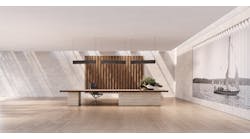Traditionally, there hasn’t been much priority placed on acoustics in architecture or its impact on our daily lives. Windows, glass walls, marble floors, skylights, steel appliances with stone countertops and hard reflective surfaces everywhere create a wall-to-wall tower of babel. This has been the norm for many years.
Yet with every generation, new things become important, and designers respond in kind. Whether it’s the need for a new motif, generations of music lovers and cell phone users worldwide, or simply a reaction to a plethora of terrible sounding spaces, acoustics is now en vogue.
Acoustics in the design process is complex. Every iota of air is part of acoustics, therefore anything which touches air affects the acoustics. Every surface, floor, ceiling, bench, sign, display case, couch, fireplace or interior element of any kind has the power to change the sound in a room. Every choice made by architects and interior designers also affects the sound.
The Basics of Acoustic Design
Function
As in architecture, we start with function. Not every office building needs to sound like a recording studio, and not every conference room needs to sound like a stadium. The function of the space determines the need for what degree of acoustical performance is required.
Many clients decide to lower or raise that bar, but at its starting point functionality is key. It will affect every decision from paint to flooring to internet to audiovisual equipment, and even floor plans and space planning.
For instance, the trend in architecture is offices with open cubicles and conference rooms. It’s less expensive than many private offices, yet allows anyone to have privacy when needed. With today’s social mores derived largely from coffeehouse behavior, it’s not a social stigma to hop into a private conference room for a call then head back to your cubicle. Conference rooms now have an acoustic performance requirement to sound better than a cubicle in a large reverberant room.
With the explosion of audiovisual teleconferencing, these rooms are even more dependent on high performance acoustics than ever before. Beautiful glass rooms with terrazzo tiles or hardwood floors are visually stunning places for meetings. However, they should include custom quantum acoustic drapery which doubles as light control for the windows, and custom dye sublimation prints over space-saving acoustic devices on walls and ceilings to control reflections while preserving the visual look of the architectural and interior design.
Time
Once function is determined, the next critical factor in the design process is time. Anything can be done with enough time – any challenge can be surmounted, any design iterated to perfection.
It’s important to get a working schedule at the beginning of a project before serious design iterations start. Things will always change, but some things simply can’t be rushed.
For example, one of our projects was a space with 100% hard surfaces. Intelligibility was terrible and speech was impossible. The client was open to pushing timing back to allow for completion of a high-performance design. Despite off-the-chart reverberation, zero intelligibility and no allowances for changes to the architecture or interior design, there was enough time to create a multilayered design, which solved every issue.
Budget
Budget is the next critical element. Once timeframe and schedule are set, it’s a matter of insuring there’s a sufficient budget for the design process as well as for the implementation of the design. As with any profession, one has to be able to run numbers from experience quickly and accurately.
Requests for bids or budgets can be required anywhere from a one-day to one-month return. Once a bid is placed it must be held to unless something changes. Budgets can be fixed, rough or final depending on the project. Regardless, the numbers must be accurate to conceptual design.
Often the hardest part of the design process is how to bid a solution which hasn’t fully been designed. This is why experience helps a great deal. If the client understands the costs up front, the design process can run its course uninterrupted by financial issues. This helps everyone understand the relationship between performance, time and cost.
How to Control Acoustics
Finally, we have the tools of the trade (the products, materials and devices) at our disposal to control sound. Now that all the nuts and bolts of function, time and budget are in order, we can look at the three categories of how to control acoustics.
This can be interpreted in many ways, but here are three successful ways:
- Electronics and software
- Traditional passive solutions
- Quantum passive solutions
Acoustics Electronics and Software
Recently we worked with an audiovisual integrator who was able to write custom code for the control systems. This controlled all the microphones, audio gain stages, video system routing and the drapery motors to insure they were pulled closed for maximum performance of the quantum drapery during use of the audio system. Because of clear communication between everyone and the integrator’s expert ability to create a custom solution, it worked well.
Traditional Passive Acoustic Solutions
As with any project, the solution requires the right tool for the right job. If a space has a slight flutter echo and no low-frequency issues, then some light, traditional-style absorption is a perfect fix both in performance and economy. For most high-frequency issues where there’s open wall space or tall ceilings, absorption can perfectly fit the bill.
Quantum Passive Acoustic Solutions
The design process is only difficult when materials specifications from the architects and interior designers change midstream. Then it’s all about adjustments and logistics. When serious mid- and low-frequency issues exist, if there is a great deal of space to allow for bass traps and deep, thick absorption, then traditional solutions can be custom fit to fix the issues to a certain degree.
Traditional solutions are ubiquitous, easy to access and inexpensive. They’re also potentially carcinogenic, hard to work with and often less functional than quantum solutions. In the design process they are simple and well known.
Quantum solutions work well at all frequencies and blend visually into environments well. They are extremely thin, lightweight and simple to install. The caveat is they’re more expensive than traditional means. In the design process they’re an architect’s best friend and heaven on earth for interior designers. Their slim profiles and extremely light weight means zero impact on floor plans and space planning.
Traits for Successful Acoustic Projects
The acoustic design process is very similar to architecture in that it’s multidisciplinary and dependent upon nearly every other discipline from HVAC, to plumbing and interior design. However, unlike the other disciplines, it requires a thorough knowledge and understanding of every other discipline to achieve true successful performance.
To design acoustics, one must be quick to adapt to changes and ready with new ideas and solutions. As always, good communication goes a long way to help insure everyone working toward the same goal -- a beautiful and beautiful sounding project.
Acoustics is a challenging field but, despite being invisible, the rewards are delightful.


